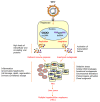Application of the woodchuck animal model for the treatment of hepatitis B virus-induced liver cancer
- PMID: 34163570
- PMCID: PMC8204361
- DOI: 10.4251/wjgo.v13.i6.509
Application of the woodchuck animal model for the treatment of hepatitis B virus-induced liver cancer
Abstract
This review describes woodchucks chronically infected with the woodchuck hepatitis virus (WHV) as an animal model for hepatocarcinogenesis and treatment of primary liver cancer or hepatocellular carcinoma (HCC) induced by the hepatitis B virus (HBV). Since laboratory animal models susceptible to HBV infection are limited, woodchucks experimentally infected with WHV, a hepatitis virus closely related to HBV, are increasingly used to enhance our understanding of virus-host interactions, immune response, and liver disease progression. A correlation of severe liver pathogenesis with high-level viral replication and deficient antiviral immunity has been established, which are present during chronic infection after WHV inoculation of neonatal woodchucks for modeling vertical HBV transmission in humans. HCC in chronic carrier woodchucks develops 17 to 36 mo after neonatal WHV infection and involves liver tumors that are comparable in size, morphology, and molecular gene signature to those of HBV-infected patients. Accordingly, woodchucks with WHV-induced liver tumors have been used for the improvement of imaging and ablation techniques of human HCC. In addition, drug efficacy studies in woodchucks with chronic WHV infection have revealed that prolonged treatment with nucleos(t)ide analogs, alone or in combination with other compounds, minimizes the risk of liver disease progression to HCC. More recently, woodchucks have been utilized in the delineation of mechanisms involved in innate and adaptive immune responses against WHV during acute, self-limited and chronic infections. Therapeutic interventions based on modulating the deficient host antiviral immunity have been explored in woodchucks for inducing functional cure in HBV-infected patients and for reducing or even delaying associated liver disease sequelae, including the onset of HCC. Therefore, woodchucks with chronic WHV infection constitute a well-characterized, fully immunocompetent animal model for HBV-induced liver cancer and for preclinical evaluation of the safety and efficacy of new modalities, which are based on chemo, gene, and immune therapy, for the prevention and treatment of HCC in patients for which current treatment options are dismal.
Keywords: Cancer treatment; Chronic infection; Hepatitis B virus; Hepatocellular carcinoma; Liver disease; Woodchuck.
©The Author(s) 2021. Published by Baishideng Publishing Group Inc. All rights reserved.
Conflict of interest statement
Conflict-of-interest statement: Manasa Suresh declares no conflict of interest for this article. Stephan Menne serves occasionally as a paid scientific consultant to Northeastern Wildlife, Inc. (Harris, ID), the only commercial source for woodchucks within the United States.
Figures



Similar articles
-
The woodchuck model of hepatitis B virus infection.ILAR J. 2001;42(2):89-102. doi: 10.1093/ilar.42.2.89. ILAR J. 2001. PMID: 11406711 Review.
-
Combination Treatment with the Vimentin-Targeting Antibody hzVSF and Tenofovir Suppresses Woodchuck Hepatitis Virus Infection in Woodchucks.Cells. 2021 Sep 5;10(9):2321. doi: 10.3390/cells10092321. Cells. 2021. PMID: 34571970 Free PMC article.
-
Measurement of Antiviral Effect and Innate Immune Response During Treatment of Primary Woodchuck Hepatocytes.Methods Mol Biol. 2017;1540:277-294. doi: 10.1007/978-1-4939-6700-1_24. Methods Mol Biol. 2017. PMID: 27975326 Free PMC article.
-
The woodchuck as an animal model for pathogenesis and therapy of chronic hepatitis B virus infection.World J Gastroenterol. 2007 Jan 7;13(1):104-24. doi: 10.3748/wjg.v13.i1.104. World J Gastroenterol. 2007. PMID: 17206759 Free PMC article. Review.
-
Prevention of liver tumor formation in woodchucks with established hepatocellular carcinoma by treatment with cationic liposome-DNA complexes.BMC Cancer. 2017 Mar 6;17(1):172. doi: 10.1186/s12885-017-3163-2. BMC Cancer. 2017. PMID: 28264666 Free PMC article.
Cited by
-
Experimental Models of Hepatocellular Carcinoma-A Preclinical Perspective.Cancers (Basel). 2021 Jul 21;13(15):3651. doi: 10.3390/cancers13153651. Cancers (Basel). 2021. PMID: 34359553 Free PMC article. Review.
-
HBV-Induced Carcinogenesis: Mechanisms, Correlation With Viral Suppression, and Implications for Treatment.Liver Int. 2025 Jan;45(1):e16202. doi: 10.1111/liv.16202. Liver Int. 2025. PMID: 39720865 Free PMC article. Review.
-
Advances in experimental animal models of hepatocellular carcinoma.Cancer Med. 2023 Jul;12(14):15261-15276. doi: 10.1002/cam4.6163. Epub 2023 May 29. Cancer Med. 2023. PMID: 37248746 Free PMC article. Review.
-
Recent Drug Development in the Woodchuck Model of Chronic Hepatitis B.Viruses. 2022 Aug 3;14(8):1711. doi: 10.3390/v14081711. Viruses. 2022. PMID: 36016334 Free PMC article. Review.
-
Toll-Like Receptor 7 Agonist RG7854 Mediates Therapeutic Efficacy and Seroconversion in Woodchucks With Chronic Hepatitis B.Front Immunol. 2022 May 23;13:884113. doi: 10.3389/fimmu.2022.884113. eCollection 2022. Front Immunol. 2022. PMID: 35677037 Free PMC article.
References
-
- Chang JJ, Lewin SR. Immunopathogenesis of hepatitis B virus infection. Immunol Cell Biol. 2007;85:16–23. - PubMed
-
- Yuen MF, Chen DS, Dusheiko GM, Janssen HLA, Lau DTY, Locarnini SA, Peters MG, Lai CL. Hepatitis B virus infection. Nat Rev Dis Primers. 2018;4:18035. - PubMed
-
- Revill PA, Chisari FV, Block JM, Dandri M, Gehring AJ, Guo H, Hu J, Kramvis A, Lampertico P, Janssen HLA, Levrero M, Li W, Liang TJ, Lim SG, Lu F, Penicaud MC, Tavis JE, Thimme R Members of the ICE-HBV Working Groups; ICE-HBV Stakeholders Group Chairs; ICE-HBV Senior Advisors. Zoulim F. A global scientific strategy to cure hepatitis B. Lancet Gastroenterol Hepatol. 2019;4:545–558. - PMC - PubMed
-
- WHO Hepatitis B. [accessed January 23, 2021] Available from: https://wwwwhoint/en/news-room/fact-sheets/detail/hepatitis-b .
Publication types
LinkOut - more resources
Full Text Sources

